Customer Feedback: The secret sauce in your product process
When I sat down to write this post on how to use customer feedback to mitigate product management pain points, I knew roughly what I wanted to say. I thought I’d run through the importance of collecting customer feedback so you can make good choices about what to build. I’d talk about the need to iterate on the changes you make and that you should follow the principle of “build-measure-learn”. And I’d explain why asking for feedback can lead to increased engagement from users, with all the benefits that engagement brings with it.
I always like to use imagery to illustrate my points, but as I searched, all I could find was memes, hundreds of them. I know our marketing team regularly posts memes and jokes on our Twitter feed and that these posts get great engagement, but why are there so many of them?
My conclusion is that product managers are experiencing the same problems everywhere, and so it’s easy to tickle their funny bones with observational comedy. With that in mind, I thought the best way to showcase the value of a good feedback mechanism was to use memes and dig into why they’re funny. My next post will look at how to create a good user feedback mechanism and rise above the problems they illustrate.
Customer Feedback mechanisms help us introduce psychological safety
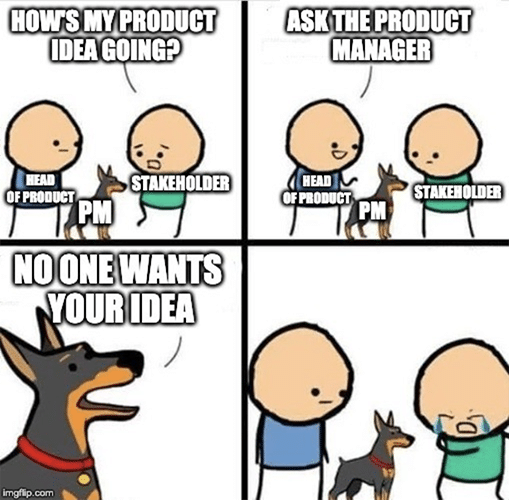
Product managers need to be able to say no, and that’s not always done with tact. But how does the PM know that their stakeholder’s idea is unpopular? How do they push back with such confidence? Maybe the PM doesn’t care about anyone’s feelings (I’m sure we’ve known people like that), or maybe they can be confident because they have feedback that supports their case.
If you’re in conflict with a stakeholder about their idea, it’s easier and less confrontational to say “feedback indicates that this isn’t something our market would benefit from”. The stakeholder isn’t wrong, the market isn’t ready for their idea. It’s the feedback’s fault. Customer feedback helps to manage conflict here, and introduces psychological safety into the discussion, so we’re more likely to stay engaged and work productively with stakeholders.
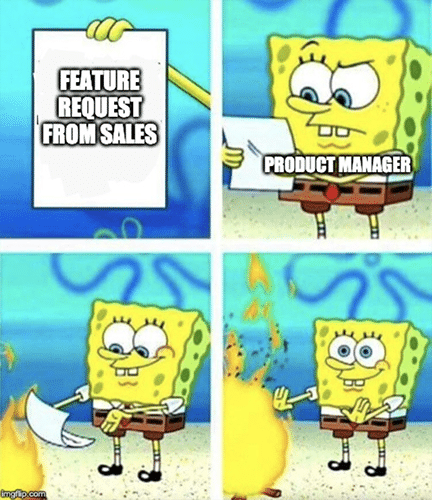
We regularly get feature requests from customer-facing colleagues – sales, operations, support, success – people who act as a proxy for an individual customer (or sometimes many) and are under pressure from them.
Spongebob is burning the feature request because he’s fed up with having to deal with this stuff. He can’t possibly act on every request he gets, and it’s easier to just burn the request than deal with it. Not only that, he knows that this isn’t going to progress, and he just can’t work out how to say so (he’s not as tactless as our Doberman dog meme). What if he had a mechanism so that the request could be used to help validate decisions, and was useful?
Just like the last meme, this situation would be easier to handle if Spongebob had a way to manage the customer feedback that lands on his desk. There would be no secrets and he’d be able to use it to make his job less confrontational and stressful.
Feedback helps us to build the right thing, and resonate with our market
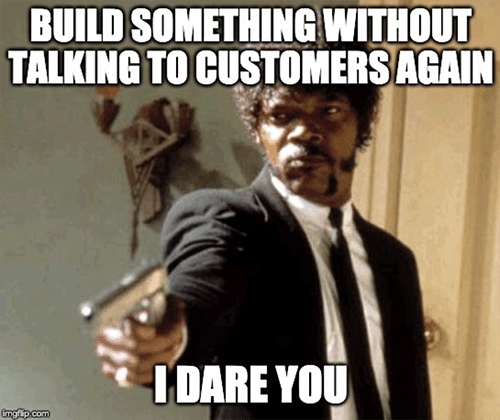
We need our products to be successful so that the organization achieves its goals and, frankly, we all continue to keep our jobs.
How do we avoid failure, or at least minimize the risk of failure? And if a product fails, and we need to change course and pivot, how do we reduce the likelihood of it failing again? The answer is to use our feedback wisely.
A launch based on an understanding of user needs is more likely to be successful. This understanding is twofold – it’s partly about understanding the user but it’s also about how we launch the product. How do we ensure our user base has the information it needs to begin using the product? How do we communicate in a way that resonates? Understanding our users means that we can build the right thing, but also that we can relate to them and help them be aware that a solution exists.
User testing is a great source of feedback

Most of us will have seen this meme or variations of it. It signifies the difference between UI and UX, how design can make something pretty, but how our users will bend what we give them to their way of working.
In reality, great designers are constantly seeking feedback from their users in order to design a user experience that works well, in addition to being aesthetically pleasing. We tend to think of customer feedback as being asynchronous, but that isn’t necessarily the case.
Let’s think about the different methods we can use to get feedback. We often think of feedback as coming in the form of feature requests by email, or in a support ticket. But what about usability testing? Beta testing? There are a number of different ways to collect feedback. When a designer puts a prototype in front of a user, or even observes them using a real product, they’re collecting feedback that can be used to iterate on the design and make it more usable, more delightful. Hopefully, that rut in the grass doesn’t appear.
Be thoughtful in how customer feedback is used
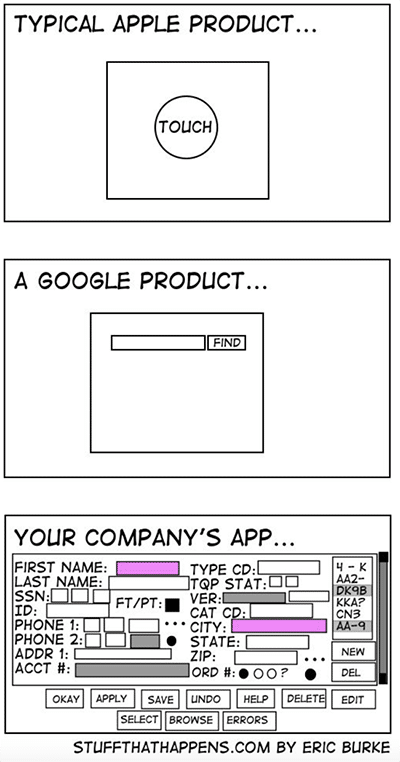
I expect many of us have seen this one. Like the last example, this is about design, and it illustrates the point that feedback isn’t a license to just do whatever the user asks for. Just because we get lots of feedback telling us to jump doesn’t mean we should ask “how high?”.
Understanding feedback is as important as collecting it. We need to ask why again, and again and again, until we really understand the user’s pain point.
I often quote the example of my 75-year-old Dad, who once rang to tell me he needed to write a macro in Excel. Rather than teach him how to do it (which would have needed some learning on my part!), I asked why. He told me he needed to make sure a specific field in his spreadsheet was filled in a certain way. I continued to ask why until I thoroughly understood the context (what spreadsheet was it, who was it for, why did they need it, what problem was it solving for them). We settled on a different solution (we just formatted the field to pick from a list of values in the end).
This solution was much simpler to implement, solved the real problem, and didn’t involve the two of us learning how to write code. He was blown away with its simplicity, and I gained valuable daughter points.
Feedback can come in the form of product analytics
In this example, think of user feedback as an expression of frustration, and an indication that there is a problem to be solved. It’s letting us know there is an opportunity to help our users, and in a business environment, to make money. In a less commercial environment, it may be an opportunity to introduce efficiency. Without access to users and a feedback loop in place, we would create complex solutions that add to frustration rather than solve problems.

Feedback doesn’t always come in the form of customer requests or individual user comments. The dictionary definition of feedback is “advice, criticism or information about how good or useful something or somebody’s work is”. I’d argue that the value of feedback is not just its content, but also the volume, prevalence, or frequency associated with it. I might have 100 pieces of feedback relating to a problem experienced by my users, for example, but if it was received over five years, from 15,000 users, it might not be that big a problem.
Data and analytics and an understanding of how to interpret them are important here. If we aren’t able to collect information from users on usage in the real world, how can we know what works and what doesn’t? User feedback comes in the form of real usage data – if our users like our product and find it useful, that will feed back to us in the form of high adoption rates. If it’s not working for some reason, we’ll see that in the data.
Reduce the friction to get more feedback
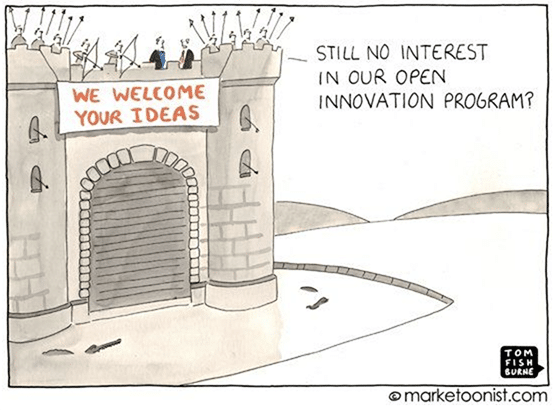
This one makes me laugh a lot. It’s a little bit like the phrase “If we build it, they will come” – but of course, users won’t react to a new feature if they don’t know about it – it’s why we have marketing. It’s the same with customer feedback – if we don’t provide an easy way for users to tell us what they think, they probably won’t bother.
They’re lots of fun, but these memes are also really useful because they genuinely showcase the value of a good customer feedback mechanism. They show us that user feedback loops can help us introduce psychological safety, that feedback helps us to build the right thing, and to ensure we resonate with the market. They also show how important it is to consider all possible forms of feedback and remind us that we need to consider carefully how we use it. If we don’t have feedback and don’t know how to use it, we’re shooting blind.
Enjoy this article?
Read on for part two and discover how to introduce an effective customer feedback process.
Alternatively, sign up for our newsletter, The Outcome, below and never miss a beat!

